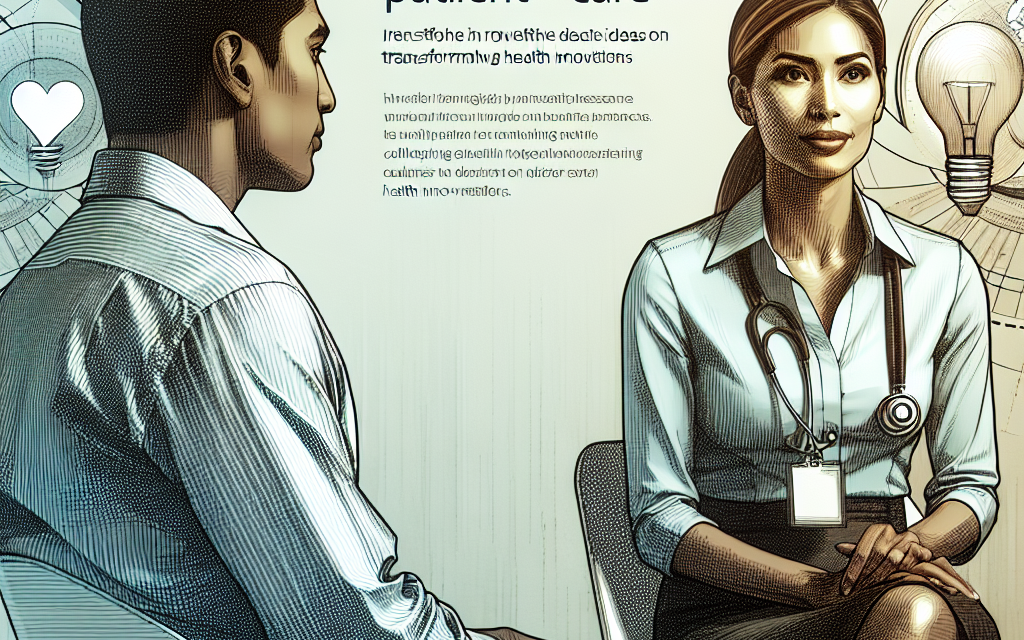Transforming Patient Care: A Conversation with Sarah Valentine and Ventsislav Dobrev on Collaborative Health Innovations
In the rapidly evolving landscape of healthcare, innovation is not just a buzzword; it is a necessity. The integration of technology and collaborative practices is reshaping how patient care is delivered, making it more efficient, personalized, and accessible. In this article, we delve into a conversation with two leading figures in healthcare innovation, Sarah Valentine and Ventsislav Dobrev, to explore the transformative power of collaborative health innovations. Through their insights, we will uncover the potential of these innovations to revolutionize patient care.
The Role of Technology in Collaborative Health Innovations
Technology has become the backbone of modern healthcare, enabling unprecedented levels of collaboration among healthcare providers, patients, and stakeholders. Sarah Valentine, a renowned healthcare strategist, emphasizes the importance of technology in bridging gaps in patient care. “Technology is not just a tool; it’s a catalyst for change,” she asserts.
One of the most significant technological advancements in healthcare is the Electronic Health Record (EHR) system. EHRs have transformed the way patient information is stored, accessed, and shared. By digitizing patient records, healthcare providers can collaborate more effectively, ensuring that all parties involved in a patient’s care have access to the same information. This reduces the risk of errors and improves the quality of care.
Moreover, telemedicine has emerged as a game-changer in collaborative health innovations. Ventsislav Dobrev, a pioneer in telehealth solutions, highlights the impact of telemedicine on patient care. “Telemedicine breaks down geographical barriers, allowing patients to access care from anywhere,” he explains. This technology not only enhances collaboration among healthcare providers but also empowers patients to take an active role in their health management.
Another technological innovation driving collaboration is the use of artificial intelligence (AI) in healthcare. AI algorithms can analyze vast amounts of data to identify patterns and predict outcomes, enabling healthcare providers to make informed decisions. For instance, AI-powered diagnostic tools can assist doctors in identifying diseases at an early stage, leading to timely interventions and improved patient outcomes.
- Electronic Health Records (EHRs)
- Telemedicine
- Artificial Intelligence (AI)
In conclusion, technology plays a pivotal role in facilitating collaborative health innovations. By leveraging EHRs, telemedicine, and AI, healthcare providers can enhance communication, improve patient outcomes, and ultimately transform patient care.
Interdisciplinary Collaboration: Breaking Down Silos in Healthcare
Interdisciplinary collaboration is essential for delivering comprehensive and holistic patient care. Sarah Valentine emphasizes the need to break down silos in healthcare, stating, “Collaboration across disciplines is crucial for addressing complex health issues.” By fostering a culture of collaboration, healthcare organizations can harness the expertise of diverse professionals to improve patient outcomes.
One successful example of interdisciplinary collaboration is the implementation of multidisciplinary care teams. These teams consist of healthcare professionals from various specialties who work together to develop and implement personalized care plans for patients. By pooling their expertise, these teams can address the multifaceted needs of patients, leading to better health outcomes.
Furthermore, interdisciplinary collaboration extends beyond healthcare providers to include patients and their families. Engaging patients in their care decisions fosters a sense of ownership and empowerment, leading to improved adherence to treatment plans and better health outcomes. Ventsislav Dobrev highlights the importance of patient-centered care, stating, “Patients are the most important members of the care team.”
Case studies have shown that interdisciplinary collaboration can lead to significant improvements in patient care. For instance, a study conducted at a major hospital found that patients who received care from multidisciplinary teams had shorter hospital stays and lower readmission rates compared to those who received care from individual providers.
- Multidisciplinary Care Teams
- Patient and Family Engagement
- Case Studies on Interdisciplinary Collaboration
In summary, interdisciplinary collaboration is a key component of collaborative health innovations. By breaking down silos and fostering a culture of collaboration, healthcare organizations can deliver more comprehensive and effective patient care.
Data-Driven Decision Making in Healthcare
Data-driven decision making is revolutionizing the way healthcare providers deliver care. By harnessing the power of data analytics, healthcare organizations can gain valuable insights into patient populations, identify trends, and make informed decisions. Sarah Valentine emphasizes the importance of data in healthcare, stating, “Data is the new currency in healthcare.”
One of the primary benefits of data-driven decision making is the ability to personalize patient care. By analyzing patient data, healthcare providers can identify individual risk factors and tailor treatment plans to meet the unique needs of each patient. This personalized approach leads to better health outcomes and improved patient satisfaction.
Moreover, data analytics can help healthcare organizations identify inefficiencies and areas for improvement. For example, by analyzing data on hospital readmissions, healthcare providers can identify patterns and implement interventions to reduce readmission rates. This not only improves patient outcomes but also reduces healthcare costs.
Ventsislav Dobrev highlights the role of predictive analytics in healthcare, stating, “Predictive analytics can help us anticipate and prevent health issues before they occur.” By leveraging predictive analytics, healthcare providers can identify patients at risk of developing chronic conditions and implement preventive measures to improve their health outcomes.
- Personalized Patient Care
- Identifying Inefficiencies
- Predictive Analytics
In conclusion, data-driven decision making is a powerful tool for transforming patient care. By leveraging data analytics, healthcare organizations can personalize care, identify inefficiencies, and implement preventive measures to improve patient outcomes.
The Impact of Policy and Regulation on Collaborative Health Innovations
Policy and regulation play a crucial role in shaping the landscape of collaborative health innovations. Sarah Valentine emphasizes the importance of supportive policies in fostering innovation, stating, “Policy and regulation can either be a barrier or a catalyst for innovation.”
One of the key challenges in implementing collaborative health innovations is navigating the complex regulatory environment. Healthcare organizations must comply with a myriad of regulations related to patient privacy, data security, and reimbursement. These regulations can pose significant challenges to innovation, but they are essential for ensuring patient safety and privacy.
Ventsislav Dobrev highlights the importance of regulatory frameworks that support innovation, stating, “Regulations should be designed to encourage innovation while ensuring patient safety.” For example, telemedicine regulations have evolved to accommodate the growing demand for virtual care, allowing healthcare providers to deliver care remotely while ensuring patient safety and privacy.
Moreover, policy and regulation can drive innovation by providing incentives for healthcare organizations to adopt collaborative practices. For instance, value-based care models incentivize healthcare providers to deliver high-quality, coordinated care by tying reimbursement to patient outcomes. This encourages healthcare organizations to adopt collaborative practices to improve patient outcomes and reduce costs.
- Regulatory Challenges
- Supportive Regulatory Frameworks
- Incentives for Collaborative Practices
In summary, policy and regulation play a critical role in shaping the landscape of collaborative health innovations. By creating supportive regulatory frameworks and providing incentives for collaboration, policymakers can drive innovation and improve patient care.
The Future of Collaborative Health Innovations
The future of collaborative health innovations is bright, with endless possibilities for improving patient care. Sarah Valentine envisions a future where technology and collaboration are seamlessly integrated into every aspect of healthcare. “The future of healthcare is collaborative,” she asserts.
One of the key trends shaping the future of collaborative health innovations is the rise of digital health platforms. These platforms enable healthcare providers, patients, and stakeholders to collaborate in real-time, facilitating seamless communication and coordination of care. By leveraging digital health platforms, healthcare organizations can deliver more efficient and effective care.
Moreover, the integration of artificial intelligence and machine learning into healthcare is set to revolutionize patient care. Ventsislav Dobrev highlights the potential of AI to transform healthcare, stating, “AI has the potential to revolutionize every aspect of healthcare, from diagnosis to treatment.” By harnessing the power of AI, healthcare providers can deliver more accurate diagnoses, personalized treatment plans, and improved patient outcomes.
Another trend shaping the future of collaborative health innovations is the growing emphasis on patient empowerment. By engaging patients in their care decisions and providing them with the tools and resources they need to manage their health, healthcare organizations can improve patient outcomes and satisfaction.
- Digital Health Platforms
- Artificial Intelligence and Machine Learning
- Patient Empowerment
In conclusion, the future of collaborative health innovations is promising, with endless possibilities for improving patient care. By embracing digital health platforms, AI, and patient empowerment, healthcare organizations can deliver more efficient, personalized, and effective care.
Conclusion
In this conversation with Sarah Valentine and Ventsislav Dobrev, we have explored the transformative power of collaborative health innovations. From the role of technology in facilitating collaboration to the impact of policy and regulation on innovation, it is clear that collaboration is essential for delivering high-quality patient care. By embracing interdisciplinary collaboration, data-driven decision making, and supportive regulatory frameworks, healthcare organizations can transform patient care and improve health outcomes. As we look to the future, the integration of digital health platforms, AI, and patient empowerment will continue to drive innovation and revolutionize patient care.





